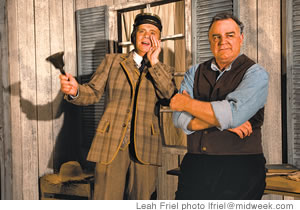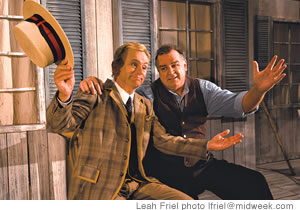Old Friends

Sajak and Moore during a rehearsal
In ‘The Boys of Autumn,’ Pat Sajak and Joe Moore tell a tale much like the one they share
I want to set the record straight. I was never the weeping ninny Mark Twain made me out to be in his novel The Adventures of Tom Sawyer. I knew Samuel Clemens before he was “Mark Twain,” when he was a wide-eyed dreamer who never could get his facts straight.
I was Tom Sawyer’s childhood sweetheart, but the true story of our love and the dark secret that tore it apart never made it into Twain’s novel. But in The Boys in Autumn, the two-man play they perform at Hawaii Theatre, you will learn the truth.
Oh, yes, I’ll be there in that majestic theater, although you will not see me. You can’t have a play about our halcyon days in Hannibal, Missouri, without recalling Tom’s leading lady and love interest.
But Thomas Gray (Tom), played by Wheel of Fortune TV game-show host Pat Sajak, and Henry Finnegan (Huck), portrayed by Hawaii news anchor Joe Moore, are the main storytellers. In fact, they are the only storytellers and carry the entire script and engaging repartee for the full-length, twoman play. That takes talent.
Sajak and Moore, old Army buddies and close friends, are reunited in this benefit performance for Hawaii Theatre out of the goodness of their hearts. They both love Hawaii and doing plays together. You’ll recall that they’ve been on the same stage before in The Odd Couple and The Honeymooners.
This is a “hana hou” you won’t want to miss.
It is also the last play they’ll do together. “We’re not exactly spring chickens,” Moore says with a laugh. “Better to go out gracefully than be thrown off the stage.”

Like Tom and Huck, Pat and Joe are pals till the end
Bernard Sabath’s play The Boys in Autumn opened on Broadway in 1986 with George C. Scott and John Cullum. Burt Lancaster and Kirk Douglas played the characters in the West Coast production. The play is a touching, often funny, sometimes bittersweet look at the changes we go through as we grow up and how we often never fully escape our past. The Mark Twain folk heroes meet up as disillusioned middle-aged men.
But let me not get ahead of myself. The best ones to talk about Hawaii’s production of this play are Moore and Sajak. As a real-life newscaster and game show host, respectively, these two are never at a loss for words!
How did the idea to do this play come up?
Moore: Pat and I were looking for a play, and I was lucky enough to stumble across this in a catalog. I had not seen it performed and was not familiar with it, but just the idea of Huck Finn and Tom Sawyer having a reunion 50 years after they parted ways as boyhood pals piqued my interest. I was blown away by the script and sent it to Pat with a note saying, “We’ve got to do this.”
Sajak: We were looking specifically for a two-man play, and Joe ran across this. I had never heard of it before, but I found the relationship between the two men – and the performing challenges – to be compelling. This will not be the Huck and Tom everyone knows. No one can do a half-century of living without going through dramatic changes. Audiences should not expect us to be whitewashing fences and getting lost in caves.
Tell us about the characters.
Moore: After reading the script, I saw myself as Huck and Pat as Tom. I think he’ll tell you he saw it the same way. The reasons we saw the casting that way, I think, will become obvious to the audience when they see the play.
Sajak: Tom Sawyer has become an old vaudevillian who has probably been more successful in his mind than in reality. He’s reached a point in his life where he feels the need to reconnect with the person who was once most important to him, and thereby reconnect to his childhood as a way to resolve some important issues for himself and give him some direction. I’ve reread some Twain just to remind myself of the relationship between Huck and Tom, but a lot of years have passed since then and, like all of us, these men have changed.
Any similarities to your real-life friendship?
Sajak: I think we all hold a nostalgic spot in our hearts for the people and events of our younger selves. While Joe and I were a bit older than these two when we met, I can’t say we were much more mature. I’m constantly surprised by how much this play and these characters touch me and take me back to my youth. There’s a melancholy aspect to it, too, because none of us can ever really go back.
Moore: Like Tom and Huck, we’re both smart alecks. Pat’s one of my dearest friends, even though we don’t see each other that often … maybe that’s why we’re such good friends (laughs). I don’t really remember my first impression of Pat in Vietnam. He was the morning DJ on American Forces Vietnam Network radio and I did radio and TV news. We roomed together with one other fellow in a Saigon hotel that was run by the Army. I left the Army a couple of months before he did, and somehow we lost track of each other. Years later he saw me on an episode of Hawaii Five-0, sent me a letter, and we started corresponding again. I think when he saw me on a nationally televised series, he thought, “If he can do that, I ought to at least be able to be a game show host or sell used cars.” And he is such a natural B.S.’er, that’s what he did. Well, he settled for the Wheel after failing as a car salesman. It’s not much for a grown man to claim as a career, but he’s a nice guy.
How did you prepare for this play?
Moore: Obviously, the first order of business is to memorize the lines, and there is a ton of dialogue. Not blessed with a photographic mind, I’ve never found an easy way to memorize lines. It’s just a process of repeating them over and over until they stick. Then the challenge becomes making sure they stick. My wife Teresa and son Bryce have been a big help in going over the material.
Pat and I used Skype on our computers every couple of weeks to help us cement the lines and get familiar with each other’s delivery and timing. The real rehearsals started June 12 under the direction of Glenn Cannon. We’ve had marathon rehearsal sessions on the weekends and twice a day on weekdays.
I love working with Glenn. He really knows his stuff. This will be the third time he’s directed me in a play, following The Heydrich Covenant and Prophecy and Honor – 2007 version. It will be the first time he’s directed Pat and me together, although the three of us did share the stage as actors in the first run of Prophecy in 1993 at Diamond Head Theatre.
Why Hawaii Theatre? Moore: We chose Hawaii Theatre as the beneficiary because we really like the people there, have enjoyed our past productions there and thought it was about time we tried to bring in some money for this great nonprofit organization. It’s no secret that performing arts venues need all the help they can get to survive.
We hope to sell out all five performances and raise all we can for the theater. We both realize this play probably won’t appeal to a younger audience, but we think adults will appreciate and enjoy it.
When Broadway playwright Bernard Sabath learned that Pat and I were donating our time and efforts to do this play as a benefit for Hawaii Theatre, he wrote us a letter saying that he was going to donate his $500 royalty fee to the theater. What a generous thing to do!
Do you prefer stage or TV as a creative medium?
Sajak: They’re so different, it’s hard to compare. Virtually everything I do on TV is off-the-cuff, and I love working that way. But there’s a great deal of satisfaction in taking a script, learning it, rehearsing, refining and perfecting it, and then, finally, performing it. There is a special thrill in doing live theatre that I haven’t experienced in any other part of my career.
Moore: Live theatre is challenging, because I don’t do it that often, usually a play every couple of years. But I enjoy it. Working before a live audience is obviously a rush, and satisfying when the performance goes well. There are a lot of things that go into a good production, the actors just being the most visible part. Fortunately for us, Pat and I have been blessed to work with outstanding production crews on our projects, and we’re delighted to have most of the ol’ gang back for this play.
What’s new with you?
Sajak: Not much. I’ve been at Wheel since 1981 and it’s still going strong. This fall, we’ll start our 28th season of the nighttime show and it’s still the No. 1 show in syndicated television. And we’re just spinning a wheel and playing hangman. Is this a great country or what?
Moore: Professionally, Pat and I talk about such things as signing new contracts over the years, and the ups and downs we’ve experienced (mostly ups). I think we both just assume we’ll retire about the same time … when the public gets tired of us. Of course, he has a slightly bigger audience to worry about than I do (chuckles). He’s almost a year older than me, although he looks much older (laughs).
We do kid each other about what an easy job the other has, but the truth is we both know there’s a lot more to what each of us does than meets the eye. When we talk about the state of modern-day broadcasting we’re coming at it as old-timers, and as such lament the preponderance of “flash” over substance.
Sajak: We both realize we’re pretty lucky when it comes to long runs, especially the way television has changed. We might act a little silly when we’re together, but we’re both very serious about our jobs, and I think it’s safe to say we each understand what it takes to be successful over the long haul. We do talk about show business, but, now that we’re getting a little older, much of what we say about the current state of affairs is not too complimentary.
Moore: I think we’ve blathered on enough.
You must be logged in to post a comment.




There are no comments
Add yours